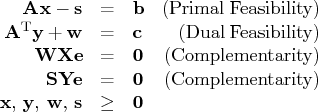| The Linear Programming Solver |
The Interior Point Algorithm: Overview
The interior point LP solver (experimental) in PROC OPTMODEL implements an infeasible primal-dual predictor-corrector interior point algorithm. To illustrate the algorithm and the concepts of duality and dual infeasibility, consider the following LP formulation (the primal):
The corresponding dual is as follows:
The dual makes an important contribution to the certificate of optimality for the primal. The primal and dual constraints combined with complementarity conditions define the first-order optimality conditions, also known as KKT (Karush-Kuhn-Tucker) conditions, which can be stated as follows:
Note: Slack variables (the ![]() vector) are automatically introduced
by the solver when necessary; it is therefore recommended that you not
introduce any slack variables explicitly. This enables the solver to handle
slack variables much more efficiently.
vector) are automatically introduced
by the solver when necessary; it is therefore recommended that you not
introduce any slack variables explicitly. This enables the solver to handle
slack variables much more efficiently.
The letters ![]()
![]()
![]() and
and ![]() denote
matrices with corresponding
denote
matrices with corresponding ![]()
![]()
![]() and
and ![]() on the main diagonal and
zero elsewhere, as in the following example:
on the main diagonal and
zero elsewhere, as in the following example:
If ![]() is a solution of the previously defined system of equations representing the KKT conditions,
then
is a solution of the previously defined system of equations representing the KKT conditions,
then ![]() is also an optimal solution to the original LP model.
is also an optimal solution to the original LP model.
At each iteration the interior point algorithm solves a large, sparse system of linear equations as follows:
The preceding system is known as the reduced KKT system. The interior point solver uses a preconditioned quasi-minimum residual algorithm to solve this system of equations efficiently.
An important feature of the interior point solver is that it takes full advantage of the sparsity in the constraint matrix, thereby enabling it to efficiently solve large-scale linear programs.
The interior point algorithm works simultaneously in the primal and dual spaces. It attains optimality when both primal and dual feasibility are achieved and when complementarity conditions hold. Therefore it is of interest to observe the following four measures:
- Relative primal infeasibility measure
 :
:
- Relative dual infeasibility measure
 :
:
- Relative duality gap
 :
:
- Absolute complementarity
 :
:
Copyright © 2008 by SAS Institute Inc., Cary, NC, USA. All rights reserved.



![\mathbf{x} \equiv [ x_1 & 0 & ... & 0 \ 0 & x_2 & ... & 0 \ \vdots & \vdots & \ddots & \vdots \ 0 & 0 & ... & x_n ]](images/lpsolver_lpsolvereq42.gif)
